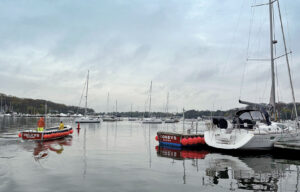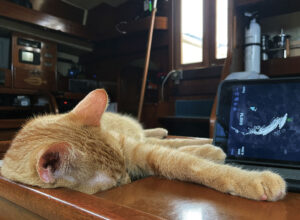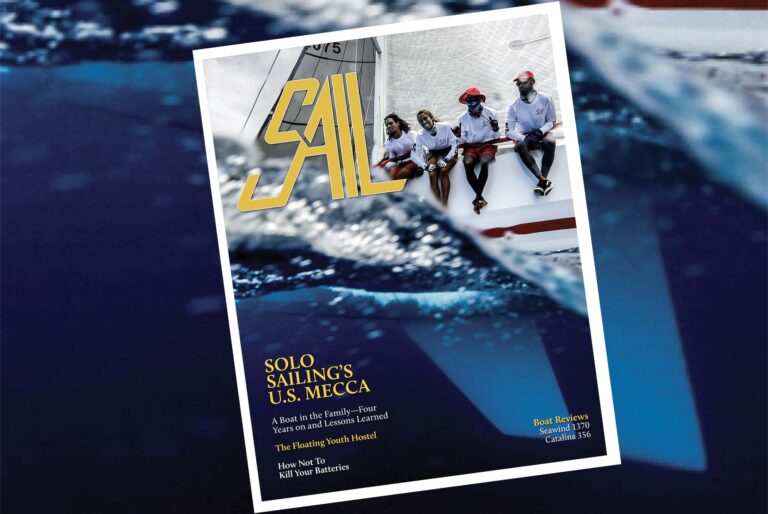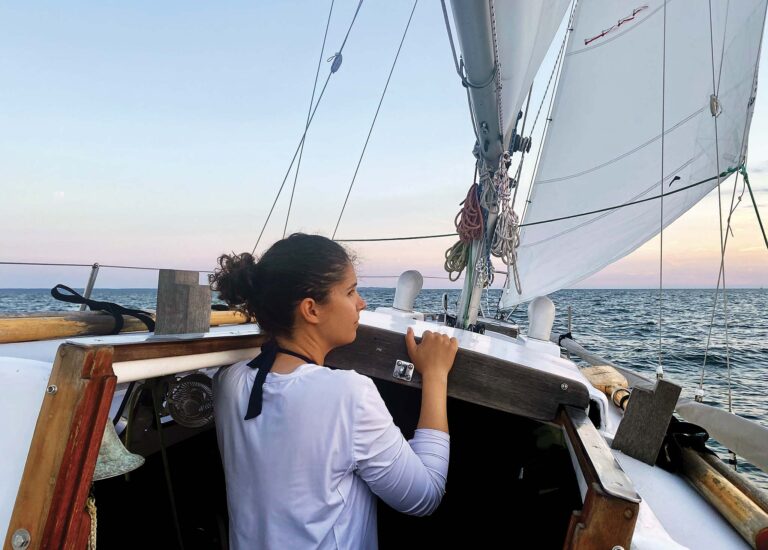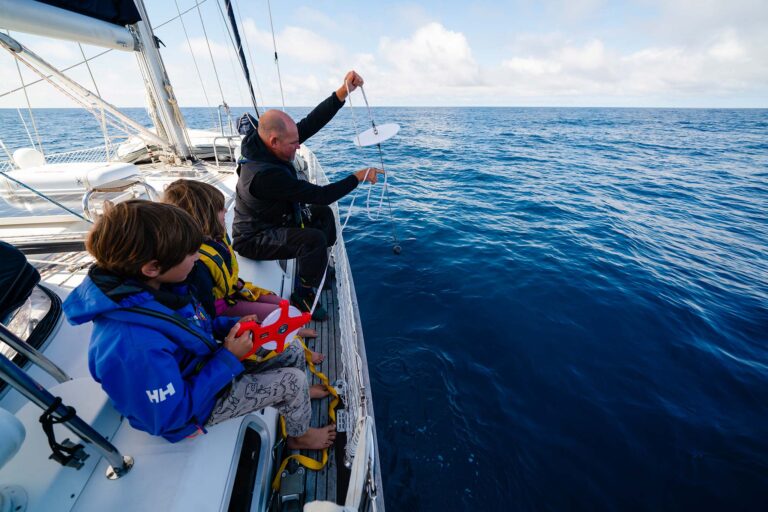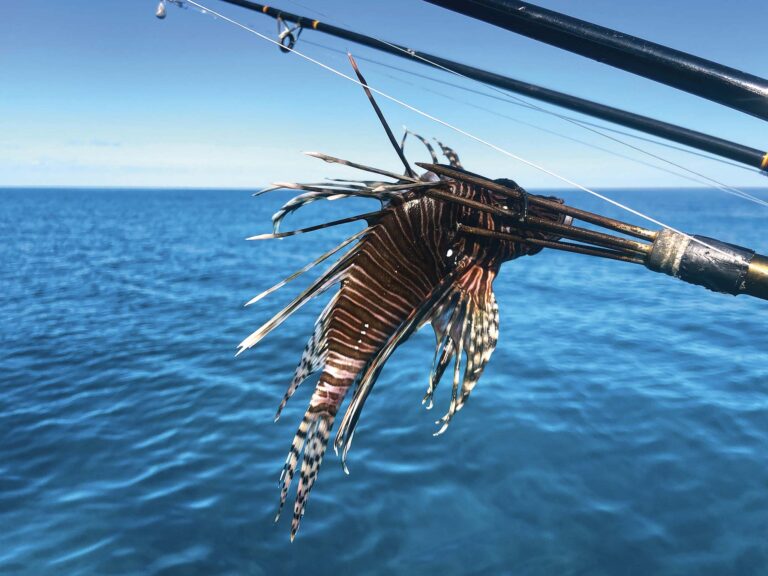I live and sail in the Coulee Region on the Mississippi River near LaCrosse, Wisconsin. I call Lake Onalaska, which is formed by Lock and Dam Number 7, my home port and have enjoyed racing and many days of leisure afloat there. I have a buddy who also owns a sailboat, and he and I decided one day that a float down the Mississippi would be a fun way to spend a weekend with the kids from our local church group. Our wives joined us as we drove upriver to Winona, Minnesota, with the boats in tow. The kids were to arrive the next morning to start the trip back downriver.
My boat was a 1971 McGregor 24 Venture. My buddy’s boat, also a 24-footer, was a Bayliner Buccaneer with an inboard 6hp Renault diesel engine. We shared a delightful evening together with pizza and drinks from a local eatery, and then slept aboard where we’d tied up the boats at the public dock by the park. The towboats stayed busy all night hauling their barges up the river, but fortunately it didn’t keep us up.
The kids began arriving at about 1100 the next day. The group included both boys and girls ranging in age from 8 to 15. Altogether we had 20 people, including our wives and another adult. We ate sack lunches and then divided the group equally between the two boats and distributed lifejackets and gear accordingly. The plan was to sail, motor or simply float part way down the river that first day and then camp ashore on an island for the night.
The wind was too light to sail, so we started out motoring. Soon, however, my buddy’s motor started heating up. The access hatch was buried under camping gear, and he didn’t want to investigate right then, so he shut his engine down, and I took his boat in tow. We were making about 5 knots. We weren’t in a hurry, and the sun was warm. The kids entertained themselves with silly songs and pirate chit-chat, bantering back and forth between the boats. Legs hung off the boats on both sides, and from above it might have looked like one many-legged water monster was chasing another down the river.
After about an hour we came into the still water above one of the many locks and dams the Army Corps of Engineers maintains on the river. We unhooked the towline between the boats and opted to sail for a while. My buddy’s engine had cooled down by now, and he planned to start it again when he needed to control his boat as we approached the dam where we would be locked through.
Sailing was a new experience for most of the kids. No engine noise. No smelly exhaust. Sails billowed out. They dodged the boom as tacks were made. Our decks were crowded, and many eager hands tried to haul lines. Eventually we got close enough to the dam to take in the sail, start our engines and get locked through.
As a more experienced sailor, I typically make sure the engine starts before striking sail. But on this day I was confident the engine, which had just pushed us all down the river with another boat in tow, would start right up, so I ordered the sail taken down and lowered my Chrysler Sailmate outboard into the water. I pushed the starter button repeatedly, but the engine didn’t start. It didn’t even fire. Meanwhile, we were getting closer and closer to the dam.
By now it was too late to raise sail again, what with the inexperienced crew and the crowded deck. My buddy could also see we were in trouble, but with engine problems of his own it was too risky for him to try to save us. The current was pulling us faster now. I didn’t know what our fate would be if we were sucked up against the dam by all the tons of water flowing under the gates.
We were swept past the warning signs, and I yelled for help to God or anyone else who could hear. I grabbed the anchor out of the lazarette, dropped it overboard, and then had to dodge the rode as it was sucked forward by the current with a mighty swish through the race 30 feet ahead.
I yelled for everyone to hang on. The concrete abutments were coming up fast. I passed a fender to the bow on the port side in hopes we could fend the boat off and then cut the anchor rode, as it was only pulling us along faster. Everyone was braced for the crash. I tried at the last moment to steer us past the concrete, but then mercifully we were becalmed in the whirlpool at the head of the dam. The force of the current was channeled down here and had much less effect on the boat.
The dam consisted of several gates that were raised and lowered from a bridge-like structure running along and above the dam. The gates were opened only to a certain level so as to maintain the water above the dam at a predetermined depth. I hate to imagine what would have happened to us if the gates were wide open, but as it happened we didn’t hit the dam that hard. Our forestay nudged the steel bridge above the gate, but did not break.
By now the Army Corps of Engineers was on the job. A small skiff came out and maneuvered parallel to the dam with its stern to my bow. We threw them a line, which they secured and used to pull us off. As they pulled, my boat was scraped along the dam by the whirlpool. The pilot of the rescue boat apologized for the damage, but we were in no position to complain.
As soon as we were safe in the calm waters of the marina above the dam, I lowered the motor into the water and discovered the fuel line had broken. A simple splice in the line got us under way again. We waved thankfully to the crew running the locks as they lowered us below the dam, and I thought grimly of the anchor we had lost in the murky depths of the river.
Later that evening with our sterns tied to trees on shore, we unloaded our gear and set up camp on what came to be known as Mosquito Island. The next morning over breakfast, we told tales of terror and compared welts. Fortunately, my wife and I had slept on the boat and suffered minimal damage, thanks to a small fan I set to blow over our faces as we lay in our berth. I don’t know for sure why it saved us, but I do know it worked.
After breakfast we discovered the impeller blades in the pump on my buddy’s engine were rotten, which was why the engine was overheating. We had no spare, so it was back to towing again. In the late morning we had another lock and dam to get through, but this time it was uneventful. By noon we were tied up at Riverside Park in La Crosse, waiting for parents from church to come and retrieve their kids. Thankfully, we had delivered them all safe and sound.
Hindsight
What we did right:
Everyone had a great time.
Lifejackets were worn at all times.
My passengers stayed calm and followed orders in our moment of danger.
What we did wrong:
We should not have been carrying so many people. The mass of people and gear hampered our ability to manage both boats when things went wrong.
I should have checked and replaced the weathered fuel hose on my outboard motor.
I should have tried to start the engine before I ordered the sail taken down.
I should have deployed the anchor as soon as the engine refused to start.
I should have asked the rescue boat to pull us out backwards so as to minimize damage to my boat.
Got a good story? We want to see it. Send it to [email protected]
Illustration by Steve Sanford



